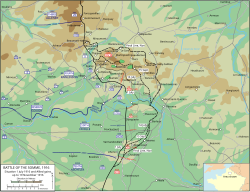
Back Delvillebos Afrikaans معركة دلفيل وود Arabic Bataille du bois Delville French Battaglia del Bosco di Delville Italian Delvillebos Dutch Batalha de Delville Wood Portuguese ڈیل ویل ووڈ کی جنگ Urdu Trận rừng d'Elville Vietnamese
| Battle of Delville Wood | |||||||
|---|---|---|---|---|---|---|---|
| Part of The Battle of the Somme of the First World War | |||||||
 | |||||||
| |||||||
| Belligerents | |||||||
|
| |||||||
| Commanders and leaders | |||||||
|
Douglas Haig Henry Rawlinson |
Fritz von Below Max von Gallwitz | ||||||
| Strength | |||||||
| 8 divisions, 1 brigade | |||||||
The Battle of Delville Wood (15 July – 3 September 1916) was a series of engagements in the 1916 Battle of the Somme in the First World War, between the armies of the German Empire and the British Empire. Delville Wood (Bois d'Elville), was a thick tangle of trees, chiefly beech and hornbeam (the wood has been replanted with oak and birch by the South African government), with dense hazel thickets, intersected by grassy rides, to the east of Longueval. As part of a general offensive starting on 14 July, which became known as the Battle of Bazentin Ridge (14–17 July), General Douglas Haig, Commander of the British Expeditionary Force, intended to capture the German second position between Delville Wood and Bazentin le Petit.
The attack achieved this objective and was a considerable though costly success. British attacks and German counter-attacks on the wood continued for the next seven weeks, until just before the Battle of Flers–Courcelette (15–17 September), the third British general attack in the Battle of the Somme. The 1st South African Infantry Brigade made its Western Front début as part of the 9th (Scottish) Division and captured Delville Wood on 15 July. The South Africans held the wood until 19 July, at a cost in casualties similar to those of many British brigades on 1 July.
The village and wood formed a salient, which could be fired on by German artillery from three sides. The ground was a rise from Bernafay and Trônes woods, to the middle of the village; the village or the wood could be held without possession of the other. After the Battle of Bazentin Ridge, the British tried to advance on both flanks to straighten the salient at Delville Wood, to reach good jumping off positions for a general attack. The Germans tried to eliminate the salient and to retain the ground, which shielded German positions from view and overlooked British positions. For the rest of July and August, both sides fought for control of the wood and village but struggled to maintain the tempo of operations.
Wet weather reduced visibility and made the movement of troops and supplies much more difficult; ammunition shortages and high casualties reduced both sides to piecemeal attacks and piecemeal defence on narrow fronts, except for a small number of bigger and wider-front attacks. Most attacks were defeated by defensive firepower and the effects of inclement weather, which frequently turned the battlefield into a mud slough. Delville Wood is well preserved with the remains of trenches, a museum and a monument to the South African Brigade at the Delville Wood South African National Memorial.

